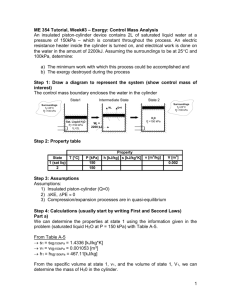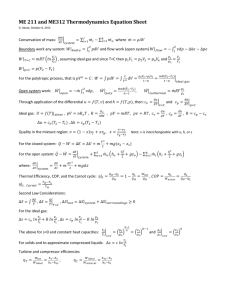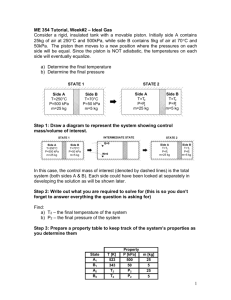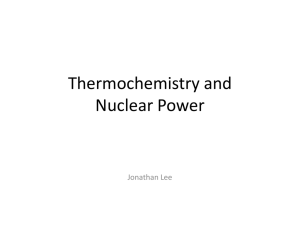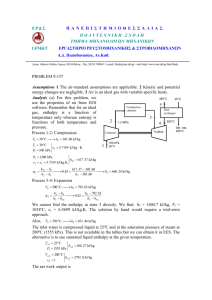ME 354 Tutorial #2 – Availability
advertisement
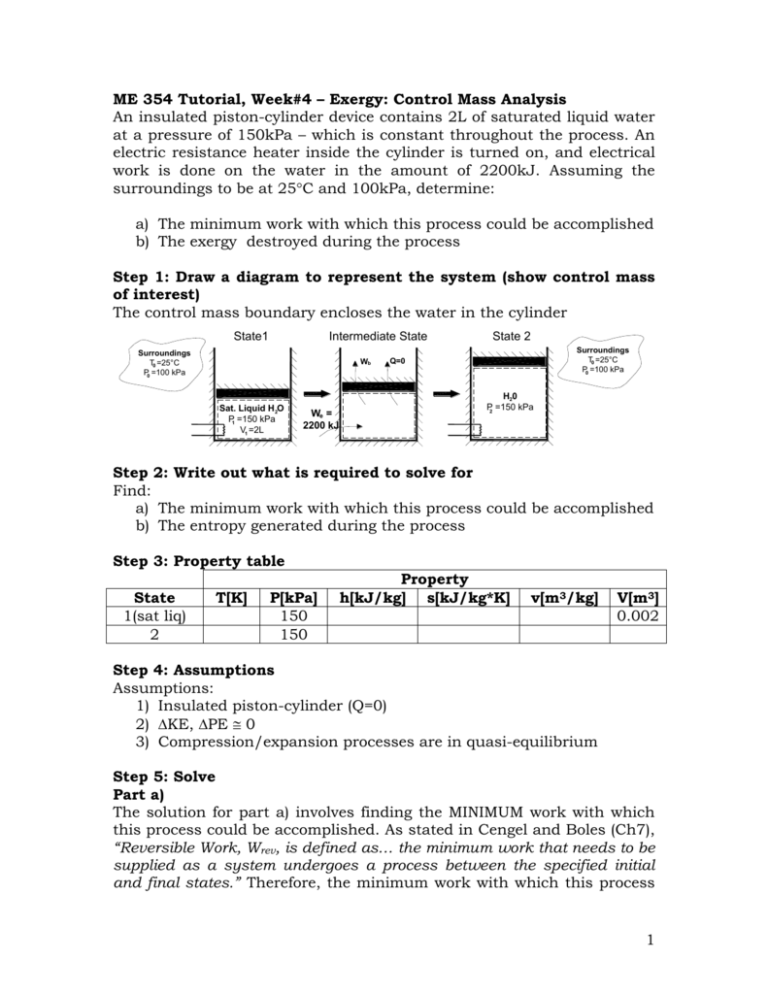
ME 354 Tutorial, Week#4 – Exergy: Control Mass Analysis An insulated piston-cylinder device contains 2L of saturated liquid water at a pressure of 150kPa – which is constant throughout the process. An electric resistance heater inside the cylinder is turned on, and electrical work is done on the water in the amount of 2200kJ. Assuming the surroundings to be at 25C and 100kPa, determine: a) The minimum work with which this process could be accomplished b) The exergy destroyed during the process Step 1: Draw a diagram to represent the system (show control mass of interest) The control mass boundary encloses the water in the cylinder State1 Intermediate State Surroundings T0 =25°C P0 =100 kPa Wb Sat. Liquid H 2O P1 =150 kPa V1 =2L We = 2200 kJ State 2 Surroundings T0 =25°C P0 =100 kPa Q=0 H20 P2 =150 kPa Step 2: Write out what is required to solve for Find: a) The minimum work with which this process could be accomplished b) The entropy generated during the process Step 3: Property table State 1(sat liq) 2 T[K] P[kPa] 150 150 Property h[kJ/kg] s[kJ/kg*K] v[m3/kg] V[m3] 0.002 Step 4: Assumptions Assumptions: 1) Insulated piston-cylinder (Q=0) 2) KE, PE 0 3) Compression/expansion processes are in quasi-equilibrium Step 5: Solve Part a) The solution for part a) involves finding the MINIMUM work with which this process could be accomplished. As stated in Cengel and Boles (Ch7), “Reversible Work, Wrev, is defined as… the minimum work that needs to be supplied as a system undergoes a process between the specified initial and final states.” Therefore, the minimum work with which this process 1 can be accomplished is equal to the reversible work. Before the reversible work can be determined, the properties of the H2O at the initial and final states must be determined. We can determine the properties at state 1 using the information given in the problem (saturated liquid H2O at P = 150 kPa) with Table A-5. From Table A-5 s1 = sf@150kPa = 1.4336 [kJ/kg*K] v1 = vf@150kPa = 0.001053 [m3/kg] h1 = hf@150kPa = 467.11[kJ/kg] From the specific volume at state 1, v1, and the volume of state 1, V1, we can determine the mass of H2O in the cylinder. mH 2O V 1 v1 0.002 m3 1.9kg m3 0.001053 kg The properties at state 2 must now be determined (the pressure at state 2 (150 kPa) is known because this is a constant pressure process). An energy balance on the system can be written to link state 2 to state 1, as shown in Eq1. E1 We Wb E2 (Eq1) Using the assumption KE, PE 0, and noting that Wb = P(V2-V1), Eq1 can be re-expressed as Eq2. U 2 U1 We P(V2 V1 ) (Eq2) Eq2 can be rearranged to Eq3. U 2 PV2 U1 PV1 We (Eq3) Recognizing that U+PV = H, and that H = mH20h, Eq3 can be rewritten as Eq4. mH 2O h2 h1 We (Eq4) Isolating h2 in Eq4, and substituting in the values for We, mH20, and h1, h2 can be determined. 2 h2 kJ kJ We 2200kJ h1 467.11 1625 mH 2O 1.9kg kg kg Using h2 = 1625 kJ/kg and P2 = 150kPa with Table A-5, we find that state 2 is within the vapor dome, in between the saturated liquid and vapor states on the 150 kPa isobar line. The properties at state 2 can determine by first finding the quality, and then using this to interpolate in Table A-5. x h2 h f hg h f 1625 467.11 0.52 2693.6 467.11 s2= sf@150kPa + xsfg@150kPa = 1.4336 + 0.52(5.7897) = 4.44 [kJ/kg*K] v2= vf@150kPa + x(vg@150kPa -vf@150kPa) = 0.001053 + 0.52(1.1582) = 0.6033 [m3/kg] As mentioned previously, the minimum work that needs to be provided to accomplish this process represents the reversible work input, which can be computed from the difference in the system exergy at state 2 and state 1, as expressed in Eq5. Wrev X 2 X 1 (Eq5) The system of exergy at states 1 and 2 can be determined from the expressions in Eq6 and Eq7 respectively. X 1 (U 1 U 0 ) T0 ( S1 S 0 ) P0 (V1 V0 ) (Eq6) X 2 (U 2 U 0 ) T0 ( S 2 S 0 ) P0 (V2 V0 ) (Eq7) Substituting Eq6 and Eq7 into Eq5, an expression for the reversible work can be obtained as shown in Eq8. (Eq8) Wmin Wrev (U 2 U1 ) T0 (S 2 S1 ) P0 (V2 V1 ) Note how the dead state properties U0, S0, and V0 cancel each other out in Eq8. Substituting the previously obtained expression for internal energy represented in Eq2 into Eq8 and bringing the mH2O outside the bracket to convert the properties to specific properties, Eq8 can be written as Eq9. Wrev We mH 2O P P0 v2 v1 T0 ( s 2 s1 ) (Eq9) 3 Substituting the known property values into Eq9, we can calculate the minimum work input. kJ kJ Wmin 2200[kJ ] 1.9[kg](150 100)(0.6033 0.001053) (298)( 4.44 1.4336) kg kg = 440.6 kJ Answer a) Part b) The exergy destroyed can be calculated from the expression shown in Eq10. X destroyed T0 S gen (Eq10) To find the entropy generated during the process we can perform an entropy balance on the system as shown in Eq11. S in S out S gen S system (Eq11) For a closed system, entropy can only be carried across the system boundary by heat transfer. Since the system is insulated, Sin = 0 and Sout = 0. The change in the system entropy is the difference in entropy between state 2 and state 1 i.e. Ssystem = mH2O(s2-s1). Using this information with Eq11, the Xdestroyed (Irreversibility) can be determined from Eq12. X destroyed T0 m H 2O ( s 2 s1 ) (Eq12) Substituting in the know values into Eq12, the Xdestroyed (Irreversibility) can be calculated. kJ X destroyed T0 S gen T0 m H 2O ( s 2 s1 ) (298[ K ])(1.9[kg])( 4.44 1.4336) kg K = 1702.2 kJ Answer b) Step 6: Concluding Statement and Remarks The minimum work with which this process could be accomplished is 440.6kJ. The amount of exergy destroyed during the actual process is 1702.2 kJ. One may question why an input of 2200kJ is required in the actual process if the process requires a minimum of 440.6kJ to accomplish it with 1702.2kJ of exergy destroyed in the actual process (which sums to 2142.8 kJ). In the actual process we still have an excess amount of work out of the system above that which is required to expand 4 against the surroundings pressure. This excess work can be expressed as (P-P0)mH2O(v2-v1), which is equal to 57.2kJ. Summing these three components together accounts for the 2200kJ input. + + = Minimum Work Input Exergy Destroyed Excess Work Output Actual Work Input = = = = 440.6 1702.2 57.2 2200 kJ kJ kJ kJ 5

